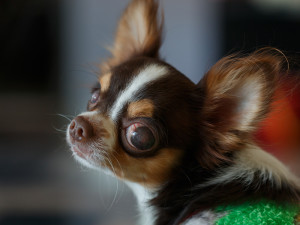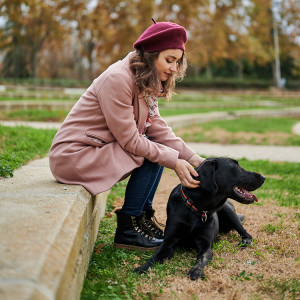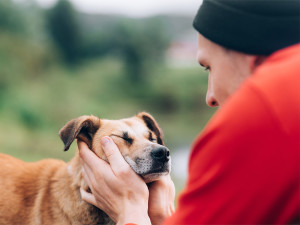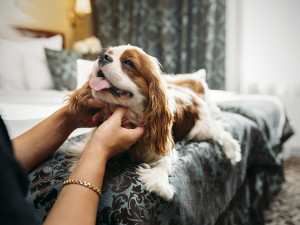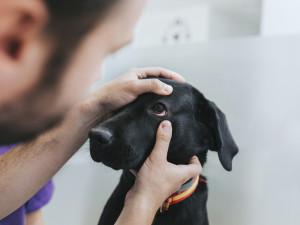Why Does Your Dog Squint at You? Learn What This Means About Them
Are they trying to tell you something, or what?

Share Article
In This Article:
Why Does Squinting Occur In Dogs? How Can You Prevent and Address Squinting? When Should You Consult a Veterinarian? Frequently Asked Questions
Do you ever catch your dog squinting at you and wonder why?
According to veterinarian Dr. Alisha Kidwellopens in new tab, “A dog’s eyes are like a roadmap to their health and emotions. Paying attention to changes, like squinting, can help you detect early health issues and keep your pup happy.”

Save on the litter with color-changing tech that helps you better care for your cat.
What’s your dog trying to say by squinting at you? Read on for possible causes, from emotional cues to medical concerns, and learn how to read your dog’s body language and expressive behavior.
Why does squinting occur in dogs?
Dogs have mastered the art of nonverbal communication. They talk with their body language and expressive eyes, from subtle head tilts to tail wags. Squinting could be anything from admiration to asking for help; all it takes is understanding and empathy to figure out a meaning.
Emotional or behavioral causes
Your dog may not speak your language, but their eyes can tell you a lot if you know how to listen. Squinting can be a sign of contentment, much like when your dog stretches out in their favorite sunny spot or wags their tail with gusto. For example, if a dog squints at you during a snuggle session or while you’re dishing out belly rubs, it’s their way of expressing happiness and affection.
However, squinting isn’t always about the warm fuzzies. Sometimes, it’s a complex form of communication. For instance, a squint paired with lowered ears and a tucked tail may indicate anxiety, unease, or submission. Dogs are masters of reading the room, and their squint could be a subtle way of diffusing tension, such as humans giving a nervous smile during an awkward meeting.
Environmental factors
Before you start overanalyzing your dog’s emotions, consider their environment. Dogs are curious creatures, sticking their noses (and faces) into everything from dusty corners to grassy fields. It’s no surprise that their eyes may get irritated sometimes.
Squinting can often be a quick reaction to environmental irritants like pollen, dust, stray blades of grass, or dander. Check for visible irritants if your dog has been exploring the great outdoors and comes back squinting. It could be allergies.
Medical concerns
As dogs age, their eyes become vulnerable to canine eye disordersopens in new tab, such as corneal ulcers and glaucoma, which may cause significant discomfort or other health problems.
Corneal ulcers, for instance, are like paper cuts on the eye — tiny but excruciating. These can happen after eye trauma, such as a playful romp in the backyard that ends with a tree branch to the face. You may notice redness, excessive blinking and squinting, and watery or yellowish discharge.
A condition known as “dry eye” can also leave your dog’s eyes irritated and itchy, while glaucoma is a sneaky condition that increases pressure in the eyes, causing vision loss.
Is your dog pawing their face? Do they act sensitive to sunshine or bright indoor lights? Are they persistently squinting? Consult a veterinarian. These are more than quirks — they’re cries for help.
How can you prevent and address squinting?
Most of the time, squinting is a harmless, endearing canine quirk. Occasional squinting is no cause for alarm, whether expressing affection, focusing on you, or signaling relaxation. Like humans, dogs have unique mannerisms, and a gentle squint often falls into the adorable category.
However, remain proactive about your dog’s eye health. Simple practices can help prevent issues before they arise. Combining preventative care with attentiveness will keep your pup happy, healthy, and expressive.
1. Make eye care a routine. Just as you wouldn’t skip an eye exam, don’t overlook your dog’s. Regular vet checkups can catch conditions like “dry eye” and corneal ulcers early, treating minor problems before they become significant and painful.
2. Control their environment. Limit irritant exposure by keeping your home clean and checking your dog’s eyes after outdoor time. Rinsing their eyes with a pet-safe saline solution can help wash away dust and debris.
3. Teach safe play habits. Supervise playtime with new toys and other dogs to prevent eye trauma. Roughhousing is normal for dogs, but it's all fun and games until your pup develops a corneal ulcer.
4. Consider protective gear. Protective goggles are practical ways to protect dogs prone to eye injuries. Yes, they make them for pups. Think of it as eye insurance for an adventurous canine.
When should you consult a veterinarian?
Call the professionals if your dog’s squinting seems pain-related or unusual and doesn’t resolve in a day or two. Persistent symptoms like redness, swelling, and discharge are reasons for an immediate vet appointment.
Sometimes, what seems like a minor irritation can indicate more serious conditions. Infections from minor scratches can escalate, while undiagnosed glaucoma can lead to irreversible damage. When in doubt, err on caution with a vet visit.
FAQs
Do dogs squint to show affection?
Absolutely. Dogs often squint during happy, relaxed moments as a way of bonding. It’s comparable to a gentle smile, symbolizing trust and adoration.
Are dogs happy when they squint?
Often, yes. A squint accompanied by relaxed body language, like soft ears and a wagging tail, is a sign of contentment.
Why does my dog squint at me when I talk?
Dogs are expert listeners, attuned to your moods, tone, and facial expressions. When they squint at you while you talk, they focus on you and try to interpret your mood even if they can’t understand your words.
References
IOSR Journals. “A Common Problems of Dog Eyes (a Review.” Academia.edu, 24 July 2021, www.academia.edu/50229225/A_Common_Problems_Of_Dog_Eyes_A_Reviewopens in new tab.
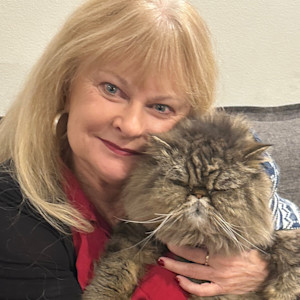
Dr. Shelby Neely, DVM
Dr. Shelby Neely is a freelance writer and veterinarian who graduated from the University of Pennsylvania School of Veterinary Medicine and has practiced veterinary medicine for thirty years, specializing in small animals. Her work has appeared in Allivet, AsktheCatDoctor, WhiskerDocs, Ask the Cat Doctor Radio, Ask the Cat Doctor TV, and numerous other websites, brochures, newsletters, newspapers, and ebooks. In her spare time, Dr. Neely likes to spend time with her three children, two grandchildren, three cats, two grand-cats, and five grand-dogs.
Related articles
![close up of Chihuahua dog's eye with cataracts]()
Common Eye Problems in Dogs and How to Treat Them
Your dog sees you as their best friend, so keep those eyes healthy.
![Woman wearing a magenta beret hat and a pink coat sitting on a wall outside and petting her black Labrador dog laying on the ground]()
How to Interpret Your Dog’s Facial Expressions and Behavior
Managing expectations about your dog’s behavior makes for a good relationship
![black and white dog looking ill laying on couch]()
Warning Signs Your Dog Needs to Go to the ER — Stat
Trust me, I’m a vet.
![A man holding a dogs face in his hands.]()
How to Manage Eye Inflammation in Dogs
This natural remedy may prove to be a key for managing symptoms without side effects.
![Cavalier King Charles Spaniel's eye is examined on the bed by a person]()
Dogs Get Dry Eye Too...Some Breeds More Than Others
Eyes without tears are only for Cameron Diaz in The Holiday.
Cherry Eye in Dogs: Why Is Your Dog’s Eye So Red?
That would be a cherry eye, and you’ll want to see your vet.
